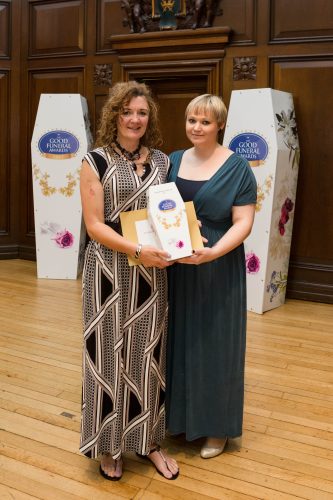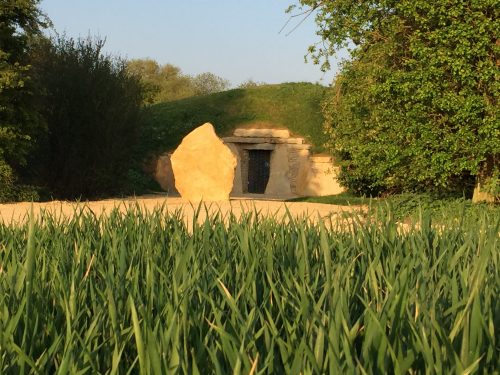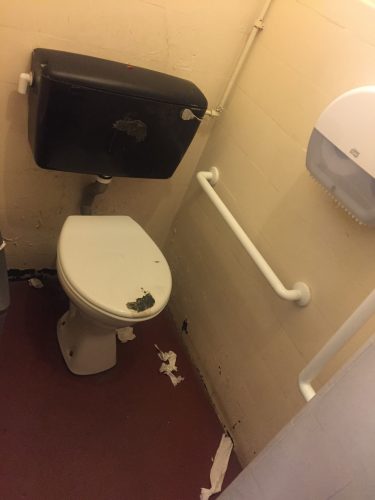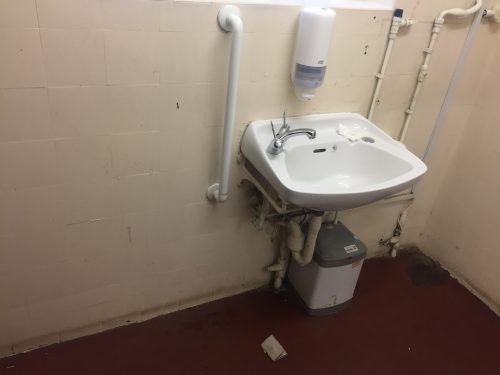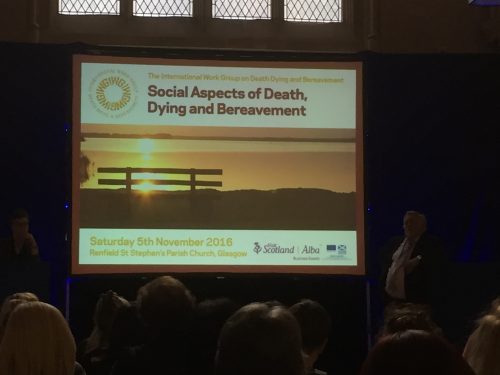A report by Matilda Munro
This blog post is an adapted version of a project completed by Matilda Munro in October 2016 as part of her Natural Sciences BSc at the Open University.
In the United Kingdom there are two main methods for disposing of the dead: cremation and burial.
Over time, cremation has increased in popularity with it now representing what happens to almost three quarters of people (The Cremation Society of Great Britain, 2015).
Cremation and burial have different environmental impacts – and within each there is variation depending on particular choices made (such as type of coffin). In cremation, the body is destroyed through burning which uses a high amount of non-renewable energy. In contrast, in burial the body decomposes slowly over time – however, in a standard burial when the body is placed deep in the ground, decomposition results in the emission of methane which is a greenhouse gas and contributes to global warming (TNO, 2011).
New processes are also in existence which are not yet regulated in England and Wales. One process in this category is alkaline hydrolysis. In brief, this involves the body being dissolved in an alkaline solution at high temperature and pressure, leaving bone ‘ash’ remains.
Those involved in the invention of refined alkaline hydrolysis methods, as well as the wider funeral industry have tried to persuade the Ministry of Justice that alkaline hydrolysis should be covered by existing legislation which covers cremation. However, this argument has been rejected to date by the government who say that since the cremation legislation references ‘burning’, it cannot be applied to alkaline hydrolysis (Thomas, 2010). This means that whilst disposing of a body through alkaline hydrolysis would not be technically illegal (provided the disposal posed no risk to public health and would not offend public decency), it would be an entirely unregulated industry. All parties involved in the industry are keen that it should be regulated from the start and hence new legislation would be desirable prior to its introduction. Regulation would provide safeguards and minimum standards, as it does for cremation and burial.
What is alkaline hydrolysis?
The process from start to finish, as explained by Sandy Sullivan the Managing Director of Resomation Ltd. (2009):
- The body, which is inside a silk or wool coffin, is placed inside the machine.
- The machine calculates the weight of the body so the right amount of water and potassium hydroxide (an alkali) is added automatically.
- The liquid is heated and held under pressure to speed up the process.
- The contents are then cooled by cold water.
- The liquid contents are drained away – this is organic matter with no DNA traces. In a standard cremation, this would have gone up the chimney of the crematorium. Here it is going to the water table.
- Porous bones are left in the Resomator
- These remains are rinsed, and dried.
- A cremulator reduces the bones to a fine powder, as in cremation.
- The resultant ash is pure white and can be returned to families in an urn.
Evidence regarding the environmental impact of alkaline hydrolysis in comparison to burial and cremation
A Life Cycle Analysis of different funeral techniques in the Netherlands was conducted with a view to concluding which method of disposal had the lowest environmental impact by TNO, the Netherlands Organisation for applied scientific research (TNO, 2011). In their research, they consider the life cycle to include the gathering of raw materials (such as those to make a coffin), preparations (such as digging a grave or heating a crematorium), carrying out the method, maintenance, processing residues and finally any transport between these steps.
TNO research (2011, see Table 1 below) shows that alkaline hydrolysis has the lowest impact across the categories measured. In some instances this is due to the environmental ‘savings’ from being able to recycle things such as metals. It is the highest contributor in the category of eutrophication. This can be altered depending on where the ashes are scattered. With particular reference to its impact on global warming, it can be seen to have a much lower impact than either burial or cremation (Figure 1).
Which method has the smallest environmental impact?
Table 1: Table of results from TNO (2011) showing the different environmental impacts of the disposal techniques
| Impact category |
Unit |
Burial (average) |
Cremation (average) |
Alkaline hydrolysis |
| Abiotic depletion (ADP) |
kg Sb eq |
1.26 |
0.82 |
-0.11 |
| Acidification (AP) |
kg SO2 eq |
1.35 |
0.67 |
-0.34 |
| Eutrophication (EP) |
kg PO43- eq |
0.75 |
0.76 |
1.08 |
| Global warming (GWP) |
kg CO2 eq |
180.3 |
79.9 |
-31.8 |
| Ozone layer depletion (ODP) |
kg CFC11 eq |
1.84E-05 |
5.53E-06 |
2.18E-06 |
| Human toxicity (HTP) |
kg 1,4- DCB eq |
115 |
54 |
-77 |
| Fresh water aquatic ecotoxicity (FAETP) |
kg 1,4- DCB eq |
34.6 |
-0.0 |
-40.0 |
| Terrestrial ecotoxicity (TETP) |
kg 1,4- DCB eq |
2.53 |
2.30 |
-0.58 |
| Photochemical oxidation (POCP) |
kg C2H2 eq |
0.16 |
0.06 |
-0.01 |
| Land competition (LC) |
m2.year |
259.8 |
70.0 |
7.0 |
Figure 1: The impact on global warming of burial, cremation and alkaline hydrolysis, based on the TNO (2011) data
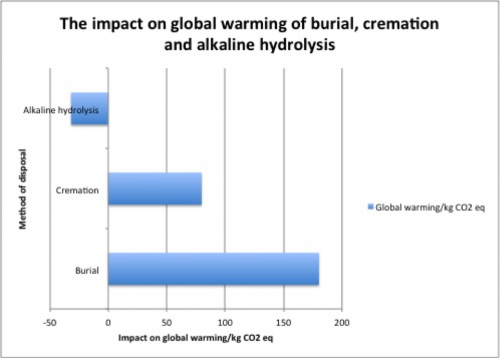
The table above (TNO, 2011) and Figure 1 show that alkaline hydrolysis has lower impacts than burial and cremation in all areas apart from eutrophication and that burial has the highest impact in all areas apart from eutrophication, with cremation in between. Out of the three methods, it is therefore the most sustainable.
The reliability of the findings
TNO were commissioned to carry out this research by Yarden, a large funeral organisation in the Netherlands. Whilst there is a potential that the vested interest of Yarden could have an influence on the findings, TNO are a reputable organisation employed to give an independent opinion. The data for cremation and burial was provided by Yarden as they are one of the largest funeral organisations and therefore have a significant amount of data. For alkaline hydrolysis, the data was based on hypothetical information provided by Resomation Ltd. This does raise some issues since it is in Resomation Ltd’s interest that it can sell itself as environmentally superior than other available options. However, in 2014, the research was updated to included actual data from Resomation Ltd. as by that point they did have data for the disposal of human remains using this method. They did not find that using the real rather than theoretical data changed their findings in any way (TNO, 2014). This data is based on average practices across the disposal methods in the Netherlands and individual choices for the funeral or memorial can easily counterbalance any environmental saving from the disposal method. For example, if a family chooses to have someone disposed of through alkaline hydrolysis, but then they fly the whole family to the Maldives to scatter the ashes, the environmental impact will be very different to a local funeral.
Apart from the TNO study of 2011, and its 2014 update, there is limited independent data specifically comparing the environmental impact of burial, cremation and alkaline hydrolysis. This is predominantly due to alkaline hydrolysis being a new method and therefore data being limited. It is possible that new studies will now take place in Scotland following the change in legislation there. It would be useful to have data like TNO’s, looking at a Life Cycle Analysis within the UK rather than in the Netherlands. The likelihood is the results would be similar as practices in both countries are more comparable than, for example, practices between the UK and United States where burial is still dominant and embalming is more widespread. However, additional data from Scotland would be useful. Notwithstanding the lack of local data, it seems unlikely that vastly different environmental conclusions would come out of further study. Given increasing population and increasing concerns regarding global warming and emissions in particular, it could be argued there is enough evidence that alkaline hydrolysis should be regulated – then it is up to the consumer to make the choice between the methods.
The views of people within the funeral industry, excluding those directly responsible for alkaline hydrolysis
The Cremation Society of Great Britain was founded in 1874 and from its inception, was open to the idea that in the future, a better means of disposal than cremation may come into existence. The original declaration stated: “Until some better method is devised we desire to adopt that usually known as cremation” (Cremation Society of Great Britain, 1999). In 2008, the Cremation Society changed their constitution to allow them to accommodate alkaline hydrolysis (Sullivan, 2009). In some states in the United States where the process is used, it is referred to as bio-cremation. Other organisations such as Co-operative Funeralcare which is one of the largest funeral directors in the UK have also expressed their support for alkaline hydrolysis as a process. In particular, they state that the environmental considerations are significant as people do want to end their life in a more environmentally friendly way (Thomas, 2010).
However, some involved in cremation do not accept the environmental argument in favour of alkaline hydrolysis. Andrew Platts of Crystal Air Solutions, for example, argues that crematoria can be carbon neutral if the heat is recycled and suitable scrubbers are fitted on the chimneys (Thomas, 2010).
The views of those behind the technique of alkaline hydrolysis
There is one company leading the way promoting alkaline hydrolysis, both in the UK and abroad. That company is Resomation Ltd., founded by Sandy Sullivan in Scotland in 2007 with the aim of promoting alkaline hydrolysis (which they call Resomation®) globally. They have patents pending on particular aspects of their technology and are the first company to have used the method to dispose of human remains in the United States (Resomation®, 2016b). Their view, unsurprisingly, is that their method of disposal provides a credible alternative to both cremation and burial – and that it represents a more environmentally friendly method than cremation.
The views of the government and the current legal situationFundamentally, alkaline hydrolysis is not illegal – but there is no legal framework by which it could be regulated as an industry in England and Wales. As explained by White (2011), the Ministry of Justice decided in 2009 that the existing Act regulating cremation cannot be applied to alkaline hydrolysis since it specifically references burning and they do not accept that alkaline hydrolysis is burning. In 2012, when alkaline hydrolysis had not yet been tried, the Under Secretary of State for Justice said that the “Government will follow with interest the progress of trials [of the alkaline hydrolysis process] in Europe and the United States” (House of Commons, 2012). In the summer of 2016, the Scottish parliament passed legislation regulating alkaline hydrolysis using their existing legislation around cremation (Scotland, Burial and Cremation (Scotland) Act 2016, s.99.1). This has now, arguably, put additional pressure on the Ministry of Justice to pass the equivalent legislation in England and Wales.
Opposition to alkaline hydrolysis as a process
There is very limited opposition to the idea of alkaline hydrolysis as a process. In general, opposition is made due to public health concerns regarding the disposal of the liquid remains (effluent) after the process is completed, though there is no evidence that it poses a public health risk. Some people argue that it is undignified and disrespectful to the deceased, or that the high pressure, high temperature unit could be dangerous (Olson, 2014).
Whilst people may initially feel disgusted or unsure of the method, once properly explained there is no reason why it could not end up as popular a choice as cremation is today. Indeed, when cremation was first introduced, it was not popular but has increased in uptake year on year (Cremation Society, 2015). Where in cremation organic matter goes up a chimney, with alkaline hydrolysis, it is returned to the water table (it has more in common with burial in this respect) (Resomation®, 2016a). In funeral homes where it has been introduced in the United States, many families are choosing to sit alongside the alkaline hydrolysis machine during the process (Sullivan, 2009).
With regard to the public health argument, when Resomation Ltd. discussed how the effluent could be disposed of in the UK, all major water companies confirmed that it would be possible for it to be entered into the mains water system for processing in the usual way. No DNA material survives the alkaline hydrolysis process so what is left is a sterile liquid (Thomas, 2010). Whilst this means water returned to homes as drinking water could indeed have come from this process, this is no different to water coming from waste treatment plants.
Proposed Solution
Given alkaline hydrolysis is not technically illegal, and given there seems to be strong consensus that as a method of disposal, it ought to be offered in England and Wales as an environmentally friendly alternative to burial or cremation, it is possible that the Cremation Society of Great Britain, or other large bodies in the industry will ‘self-regulate’ the process – particularly as it has now been covered by specific legislation in Scotland. If this were to happen, the risk would be that the government would have to react and legislate retrospectively rather than proactively, now, while the industry do not provide alkaline hydrolysis as an option for disposal. This matter has now been ongoing since 2009 and the situation in Scotland does apply additional pressure to the government of England and Wales. Why should the same method be regulated on one side of the border and unregulated or unavailable on the other?
In England and Wales, there are two main ways that the Secretary of State could regulate alkaline hydrolysis. One involves amending the Cremation Act of 1902, and the other involves using powers from the Public Health (Control of Disease) Act 1984. For the Cremation Act of 1902 to apply to alkaline hydrolysis, this Act would have to be amended and passed by parliament. Draft legislation to this end was produced by White (2011) who is also a member of the Council of the Cremation Society of Great Britain. This shows that there is support for this legislation even in areas from which one might expect to find opposition.
Conclusion
Under current legislation, whilst any method of disposal that does not offend public decency or cause a risk to public health is permitted, the methods which are regulated by government legislation are burial and cremation. Between these two methods, the evidence shows that cremation is more sustainable than burial. When alkaline hydrolysis is considered, the environmental arguments in its favour are strong, and backed with independent evidence. The first cremation took place in 1886 in Woking, as organised by the Cremation Society of Great Britain who then worked hard to bring about the Cremation Act of 1902. It is perhaps significant that cremation started before being fully legislated (as it too would not have been illegal for the same reasons alkaline hydrolysis is not illegal today). If the government accepts that it is preferable to legislate in advance rather than retrospectively, then they will need to act soon. The government has the opportunity, along with 13 states in the United States and Scotland, to be global leaders in this sustainable method for the disposal of human remains.
Update:
In April 2017, it was announced that Sandwell Council has approved plans to extend Rowley Regis Crematorium to house a Resomator machine. See here.
References
Cameo (2016) Sharing the burden [Online]. Available at http://www.cameoonline.org.uk/ (Accessed 19 September 2016)
The Cremation Society of Great Britain (1974) History of Modern Cremation in Great Britain from 1874: The First Hundred Years [Online]. Available at http://www.srgw.info/CremSoc/History/HistSocy.html#introduction (Accessed 27 September 2016)
The Cremation Society of Great Britain (2015) Progress of cremation in England and Wales Scotland and N. Ireland 1885-2014 [Online]. Available at http://www.srgw.info/CremSoc4/Stats/National/ProgressF.html (Accessed 12 September 2016)
House of Commons (2012) Hansard, 5 September, Volume 549, Column 354 [Online]. Available at https://hansard.parliament.uk/Commons/2012-09-05/debates/12090536000002/BurialSpace?highlight=alkaline%20hydrolysis#contribution-12090536001265 (Accessed 29 September 2016).
Lockart, Z. (2016) Green Reaper [Collage]. Private collection.
The Mayo Clinic (2016) Body donation at Mayo Clinic [Online]. Available at http://www.mayoclinic.org/body-donation/biocremation-resomation (Accessed 15 September 2016)
Ministry of Justice (2007) Burial Grounds: The results of a survey of burial grounds in England and Wales [Online]. Available at https://www.gov.uk/government/uploads/system/uploads/attachment_data/file/217908/burial_grounds_web_whole_plus_bookmarks.pdf (Accessed 29 September 2016)
Olson, P. (2014) ‘Flush and Bone: Funeralizing alkaline hydrolysis in the United States’, Science, Technology and Human Values, vol. 39, no. 5, pp. 666-693 [Online]. DOI: 10.1177/0162243914530475 (Accessed 21 September 2016)
Resomation® (2016a) A need for change [Online]. Available at http://resomation.com/about/need-for-change/ (Accessed 15 September 2016)
Resomation® (2016b) Who are we [Online]. Available at http://resomation.com/about/who-are-we/ (Accessed 15 September 2016)
Resomation® (2016c) News [Online]. Available at http://resomation.com/news/ (Accessed 15 September 2016)
Rumble, H., Troyer, T., Walter, T. and Woodthorpe, K. (2014) ‘Disposal or dispersal? Environmentalism and final treatment of the British dead’. Mortality, vol. 19, no. 3, pp. 243-260 [Online]. DOI: http://dx.doi.org/10.1080/13576275.2014.920315 (Accessed 19 September 2016)
Scotland. Cremation and Burial (Scotland) Act 2016, a.s.p. 20.
Sullivan, S. (2009) ‘Resomation®: Update’, Pharos International, vol. 75, pp. 4-8.
Thomas, H. (2010) Resomation: The Debate (Part 1), Pharos International, vol. 76, pp. 4-8.
TNO (2011) Environmental impact of different funeral technologies, Utrecht, TNO, 034.24026.
TNO (2014) Environmental impacts of different funeral techniques – update of prior TNO research [Online]. Available at https://www.tno.nl/en/about-tno/news/2014/12/environmental-impacts-of-different-funeral-techniques-update-of-prior-tno-research/ (Accessed 19 September 2016)
White, S. (2011) ‘The Public Health (Aquification) (England and Wales) Regulations?’. Pharos International, vol. 77, pp. 10-11.

